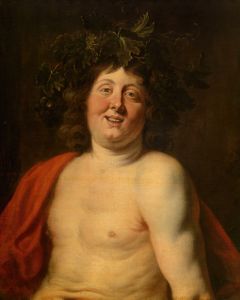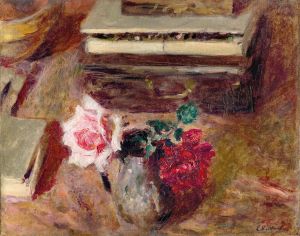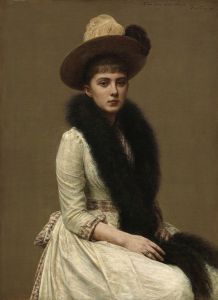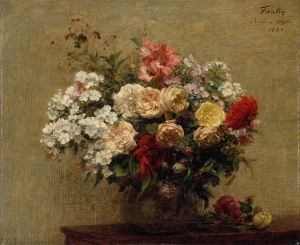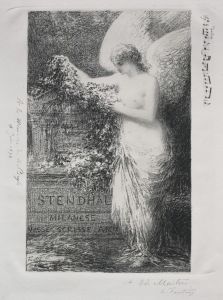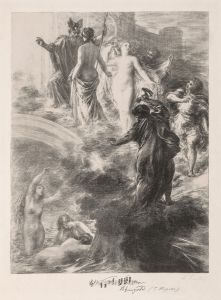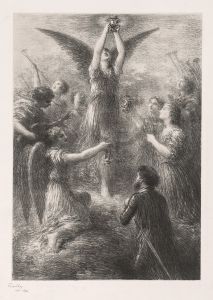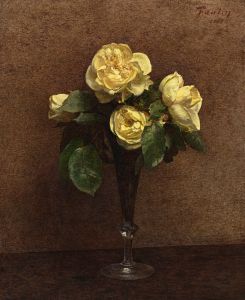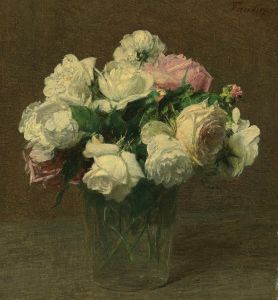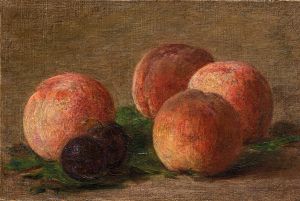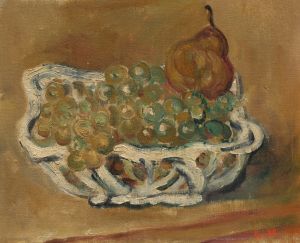
Nature Morte; Vase De Roses, Pêches Et Raisins
A hand-painted replica of Henri Fantin-Latour’s masterpiece Nature Morte; Vase De Roses, Pêches Et Raisins, meticulously crafted by professional artists to capture the true essence of the original. Each piece is created with museum-quality canvas and rare mineral pigments, carefully painted by experienced artists with delicate brushstrokes and rich, layered colors to perfectly recreate the texture of the original artwork. Unlike machine-printed reproductions, this hand-painted version brings the painting to life, infused with the artist’s emotions and skill in every stroke. Whether for personal collection or home decoration, it instantly elevates the artistic atmosphere of any space.
Henri Fantin-Latour, a renowned French painter, is celebrated for his exquisite still life paintings and portraits. One of his notable works, "Nature Morte; Vase De Roses, Pêches Et Raisins," exemplifies his mastery in capturing the delicate beauty of floral and fruit arrangements. Painted in the 19th century, this artwork reflects Fantin-Latour's meticulous attention to detail and his ability to convey texture and color with remarkable precision.
Fantin-Latour was born on January 14, 1836, in Grenoble, France. He studied at the École des Beaux-Arts in Paris and was influenced by the works of the Old Masters, which is evident in his approach to still life painting. Unlike many of his contemporaries who were drawn to the Impressionist movement, Fantin-Latour remained committed to a more traditional style, focusing on realism and the careful observation of nature.
"Nature Morte; Vase De Roses, Pêches Et Raisins" is a testament to Fantin-Latour's skill in composition and his keen eye for detail. The painting features a vase filled with roses, accompanied by peaches and grapes, arranged on a table. The choice of subjects—flowers and fruits—was common in still life paintings, allowing artists to explore themes of beauty, abundance, and the passage of time. Fantin-Latour's rendering of the roses is particularly noteworthy; he captures the delicate petals and subtle variations in color with a softness that suggests both fragility and vitality.
The peaches and grapes in the painting are depicted with equal care, showcasing Fantin-Latour's ability to convey the texture and form of different surfaces. The peaches appear ripe and velvety, while the grapes glisten with a sense of freshness. The interplay of light and shadow in the composition adds depth and dimension, enhancing the realism of the scene.
Fantin-Latour's still lifes were highly regarded during his lifetime and continue to be appreciated for their technical excellence and aesthetic appeal. His works were exhibited at the Paris Salon, and he gained recognition among art collectors and critics. Despite the rise of Impressionism and other avant-garde movements, Fantin-Latour's commitment to realism and his unique artistic vision earned him a distinct place in the art world.
In addition to his still life paintings, Fantin-Latour was known for his portraits and group portraits of prominent artists and musicians of his time. He maintained friendships with several Impressionist painters, including Édouard Manet and Edgar Degas, and was influenced by their ideas, although he did not fully embrace their style.
"Nature Morte; Vase De Roses, Pêches Et Raisins" exemplifies the qualities that define Fantin-Latour's work: a harmonious composition, a refined color palette, and an unwavering dedication to capturing the beauty of the natural world. His ability to infuse everyday objects with a sense of grace and elegance has left a lasting impact on the genre of still life painting.
Today, Henri Fantin-Latour's paintings are held in high esteem and can be found in major museums and private collections worldwide. His contribution to the art of still life remains significant, and his works continue to inspire artists and art enthusiasts alike.





